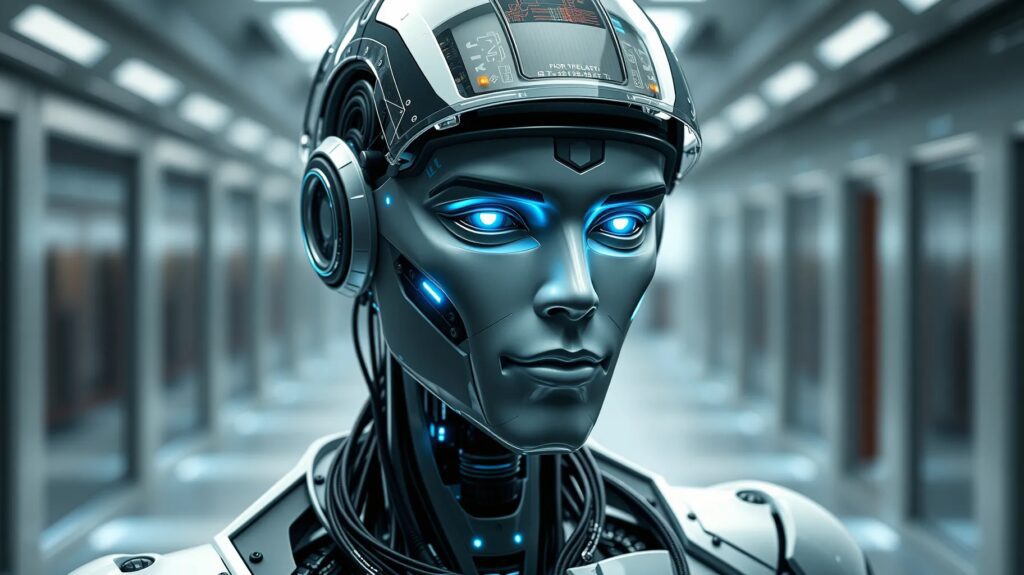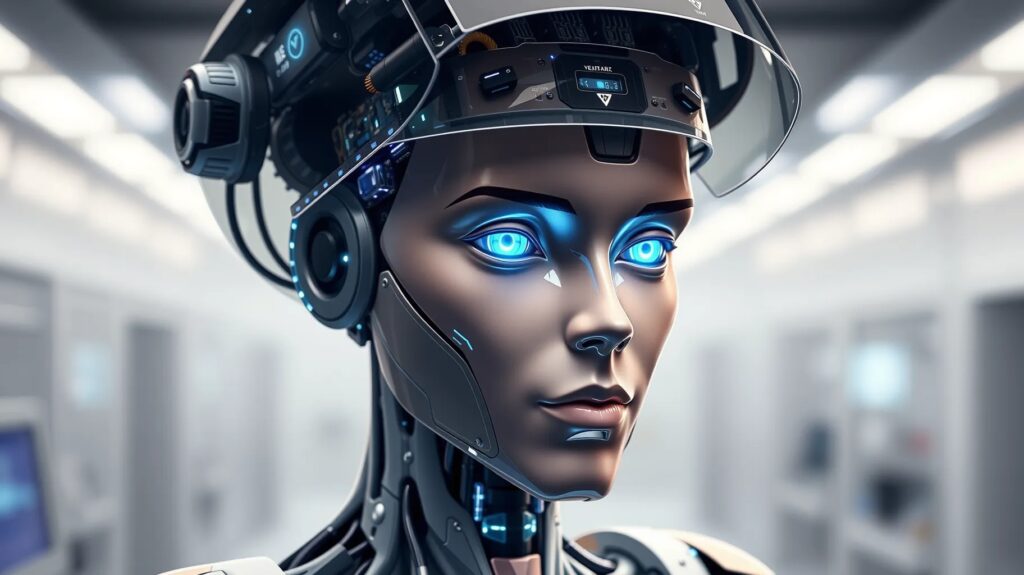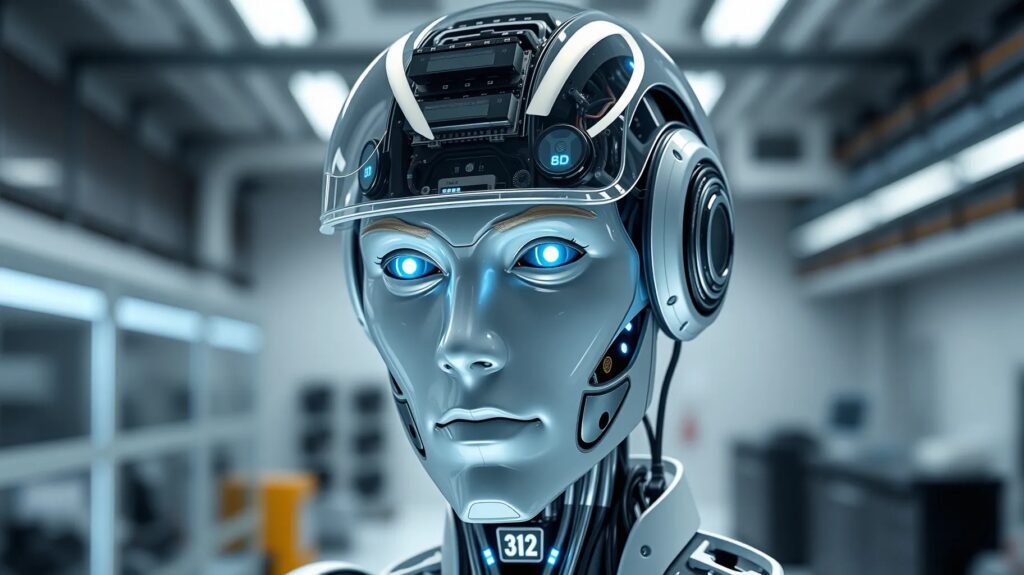
We’re exploring how robots might learn human-like social intelligence—a complex blend of empathy, adaptability, and context sensitivity that helps us connect with each other.
But can embodied AI (AI with physical presence) actually learn these nuanced human cues, or is it a feat too intricate for machines?
In this article, we’ll break down the potential and the limits of teaching robots to understand us on a deeper social level, along with the latest research and real-world applications.
The Basics: What Is Embodied AI?
Defining Embodied AI and Social Intelligence
Embodied AI refers to artificial intelligence systems that interact physically with their surroundings, often through robots with sensors, cameras, and other feedback mechanisms. Unlike disembodied AI (such as text-based chatbots), embodied AI engages in real-time interactions within our physical spaces.
Social intelligence, on the other hand, is the ability to understand and interpret others’ emotions, intentions, and actions. It includes adapting to social cues like body language, tone, and context, making it essential in forming human connections.
Why Social Intelligence Matters for Robots
Social intelligence enables robots to function smoothly in settings where humans are central, like healthcare, customer service, and education. Without social intelligence, a robot might struggle with basic interactions, risking misunderstandings or even mistrust among users. For example, imagine a robot assistant that lacks the ability to interpret tone—its responses might seem cold or misaligned with the user’s emotions, resulting in frustration or discomfort.
The Real Challenge: Human Cues Are Subtle
Human social cues aren’t always explicit. We often communicate emotions through micro-expressions, gestures, or even silence. Recognizing these subtle cues requires not just pattern recognition but a nuanced understanding of context—a high bar for robots to meet.
Advances in Teaching Robots Human-Like Social Skills
Learning Through Interaction: Reinforcement and Imitation Learning
Robots typically learn social cues through reinforcement learning and imitation learning. In reinforcement learning, they get “rewarded” for correct responses during human interaction, gradually improving their responses. Imitation learning allows robots to mimic human behavior by observing and replicating actions. These techniques help robots grasp basic behaviors, like mirroring a person’s body language to build rapport.
Natural Language Processing for Emotional Sensitivity
AI’s understanding of language has evolved with natural language processing (NLP) advancements, especially in emotion and sentiment analysis. By recognizing keywords and emotional undertones in human speech, robots can better understand and react to a speaker’s mood. NLP has grown sophisticated enough to detect subtleties like sarcasm, but robots still struggle with the full spectrum of human emotion, which often depends on complex contextual cues.
Facial Recognition and Gesture Analysis
Facial recognition and gesture analysis help robots interpret non-verbal cues like expressions or physical postures. By identifying sadness, excitement, or hesitation, robots can adjust their behavior to respond empathetically. However, these systems face limitations in diverse social contexts, as expressions vary widely across cultures and individuals.
Real-World Applications of Socially Intelligent Robots

Healthcare Companions for the Elderly
In elderly care, social intelligence is crucial. Robots are being developed to offer companionship, assist with daily tasks, and even detect early signs of cognitive decline. For example, robots like PARO the therapeutic seal provide calming interactions, recognizing emotional states through tone of voice and touch. Such robots are designed to engage in soothing and reassuring behavior, reducing loneliness among seniors.
Teaching Assistance and Student Interaction
Socially intelligent robots are also making strides in education. These robots support students by adjusting to individual learning styles, offering encouragement, and detecting frustration or boredom. An example is the Nao robot, which assists in teaching social skills to children with autism. The robot’s ability to respond to expressions and adapt to different communication styles helps kids feel more comfortable and engaged.
Customer Service Robots
Retail and hospitality industries are exploring social robots that provide personalized customer service. Robots with social intelligence can enhance user experiences, guiding people through stores, answering questions, and making recommendations based on the customer’s tone and body language. Companies like SoftBank use their robot, Pepper, in retail settings to interact with customers in a friendly, engaging manner.
The Ethical Dimensions of Socially Intelligent Robots
Privacy Concerns with Emotion Detection
As robots become more adept at reading emotions, they’re often collecting sensitive data like facial expressions, voice tones, and behavioral patterns. This raises ethical concerns around privacy, especially if robots are deployed in private spaces. Should these interactions be recorded or analyzed, and who should have access to this data? Privacy protections and transparent data policies will be crucial as social robots become more widespread.
The Risk of Emotional Dependency
When robots simulate empathy and understanding, there’s a risk that people may form emotional attachments. Elderly users or children may rely on robotic companionship, blurring lines between artificial and real relationships. While beneficial in some contexts, it raises questions about the emotional impact of forming bonds with machines that lack true emotional depth.
Barriers to Teaching Robots Nuanced Social Cues

Complexity of Human Emotions and Context
Human emotions aren’t always straightforward. They can be complex, layered, and influenced by numerous contextual factors like personal history, environment, and mood. For instance, a frown could mean sadness, concentration, or even frustration, depending on the situation. Teaching robots to decode this complexity is challenging, as context isn’t always immediately visible and can shift suddenly. While AI can process data and respond in predictable ways, interpreting layered emotional states remains an elusive skill.
Cultural Variability in Social Cues
Social cues vary dramatically across cultures. Eye contact might signal respect in some cultures, while in others it could be perceived as confrontational. These subtle differences make it difficult for a robot to apply generalized social rules to every interaction. Culture-specific programming may help, but it also risks stereotyping or oversimplifying complex social norms. Teaching robots to be sensitive to these differences without hard-coding every possible variation is a major ongoing challenge in embodied AI development.
Limitations of Current Sensors and Feedback Mechanisms
Even with advances in sensors and feedback technologies, most robots lack the full range of sensory input needed to understand the complete picture. For example, current robots can track facial expressions and tone but often miss subtleties like minor shifts in body language or changes in breathing that might signal a change in emotion. Although some robots are equipped with haptic sensors to detect touch and pressure, this sensory capacity is still basic compared to human perception.
How Robots Might Overcome Social Intelligence Barriers
Multi-Sensory Integration for a Holistic Understanding
One promising approach involves multi-sensory integration, where robots combine data from several sources—such as visual, auditory, and tactile sensors—to build a more comprehensive understanding of a human’s emotional state. By fusing this information, robots could potentially make more accurate inferences. For instance, pairing facial recognition with tone analysis might allow the robot to differentiate between sarcasm and genuine excitement.
Continual Learning Through Real-Time Interaction
To navigate ever-changing human behaviors, robots can be designed to learn continuously through interaction. By incorporating machine learning algorithms that analyze feedback over time, robots could gradually refine their interpretations of specific users’ behaviors, adapting to unique social preferences and quirks. This ongoing learning enables robots to improve their social intelligence in a way that’s individualized and dynamic, potentially enhancing user satisfaction and engagement.
Context-Aware Programming
Context-aware programming allows robots to respond not just based on immediate social cues but also by considering broader situational factors. For example, a customer service robot could interpret a person’s frustration in a long line differently than in a casual chat, adjusting its tone and response style accordingly. By embedding contextually relevant data into a robot’s programming, developers can enhance the robot’s ability to gauge and adapt to different environments.
The Future of Socially Intelligent Robots in Daily Life

Autonomous Companions for Personal and Mental Health Support
In the future, socially intelligent robots may be equipped to act as autonomous companions that help with mental health, offering emotional support or guidance. For example, a robot could be programmed to identify signs of stress or anxiety in users and respond with calming activities, suggest mindfulness practices, or encourage self-care routines. This capability could extend into fields like therapy, where AI could supplement human counselors by monitoring mood changes between sessions.
Workplace Collaborators with Social Awareness
Socially aware robots in workplaces could help foster better teamwork and productivity. Imagine a robot that supports employees by managing tasks while gauging team members’ stress levels, pacing, and collaboration styles. A robot that recognizes when someone is feeling overworked or excluded could subtly intervene by redistributing tasks or suggesting a break. By aligning their responses with team dynamics, robots could potentially make workplaces more efficient and human-centered.
Household Robots Attuned to Family Dynamics
As robots enter homes, their ability to adapt to family-specific social dynamics will be essential. A robot could recognize patterns within a family and adjust its responses accordingly. For instance, if it detects tension between family members, it might adopt a softer, more diplomatic tone. Robots could even learn to support children and teenagers by engaging with them in an age-appropriate, empathetic manner, assisting with tasks, and adapting based on individual personalities.
Final Thoughts: Can Robots Truly Understand Us?
The journey to creating socially intelligent robots is advancing, but there’s still a long way to go. Although robots can now grasp simple social cues, deeper understanding—particularly with complex emotions and nuanced contexts—remains a major hurdle. Socially intelligent robots have a future in healthcare, education, and even our daily lives, but they will need continuous learning and cultural sensitivity to thrive alongside humans.
With the right developments, robots may eventually become skilled companions and collaborators. But for now, genuine emotional intelligence is a distinctly human trait that robots can only approximate.
FAQs
What’s the difference between embodied AI and other AI types?
Embodied AI refers to AI systems with a physical presence—robots that interact directly with their surroundings. Unlike software-based AI, such as virtual assistants, embodied AI engages with the physical world and responds in real time, using sensors, cameras, and other feedback mechanisms. This physicality enables embodied AI to interact with humans more naturally, but it also requires advanced social intelligence to interpret subtle human cues accurately.
Can robots understand human emotions?
Robots can recognize basic emotions like happiness, sadness, or anger through facial recognition and tone analysis. However, fully understanding human emotions requires more than recognizing expressions; it involves interpreting context, cultural background, and individual personality. While robots are improving in emotional recognition, they still struggle with complex or nuanced emotions and rely on programmed responses rather than genuine empathy.
Are there ethical concerns with socially intelligent robots?
Yes, there are several ethical concerns. Privacy is a major issue, as social robots often gather sensitive data like facial expressions, speech, and behavioral patterns. Another concern is emotional dependency, especially among vulnerable groups like the elderly or children, who may form bonds with robots. Additionally, socially intelligent robots may raise issues around consent and data security, especially in sensitive environments like homes and healthcare facilities.
Can robots adapt to different cultural social cues?
Adapting to cultural cues is challenging for robots due to the vast differences in social norms worldwide. Some developers are exploring culture-specific programming to help robots recognize basic differences in behavior, such as variations in eye contact or personal space preferences. However, it’s difficult to cover all cultural nuances without oversimplification. The goal is for robots to be adaptable without stereotyping, a complex task that requires ongoing research and development.
How do robots use multi-sensory input to understand social interactions?
Multi-sensory input combines data from visual, auditory, and tactile sensors, allowing robots to build a more accurate picture of a social interaction. By analyzing a person’s facial expression, tone, and even physical gestures simultaneously, robots can make more informed responses. This approach aims to mimic human perception, though it’s still limited by current technology and doesn’t yet match the complexity of human understanding.
What are the main uses of socially intelligent robots today?
Today, socially intelligent robots are primarily used in healthcare, education, and customer service. In healthcare, they offer companionship and support for elderly patients. In education, they assist teachers by helping children learn social and emotional skills. Retail and hospitality settings also employ social robots to improve customer experiences by providing guidance, answering questions, and offering product suggestions.
Will robots ever fully understand human social intelligence?
While robots are improving in understanding basic social cues, fully replicating human social intelligence remains challenging. Human social intelligence involves deep emotional understanding, empathy, and adaptability—traits that robots can only approximate. Although robots may one day become highly skilled in recognizing and responding to human emotions, achieving a level of nuanced, human-like understanding is still far in the future.
What technologies enable robots to recognize facial expressions?
Robots recognize facial expressions using facial recognition software and machine learning algorithms. High-resolution cameras capture facial features, and algorithms analyze these images for specific markers—like raised eyebrows or frowns—that correlate with emotions. Machine learning helps improve this process over time, allowing robots to better recognize expressions across various faces. However, facial recognition accuracy can be limited by lighting, angle, and even individual differences, so robots may still misinterpret certain emotions.
Can robots learn from social interactions over time?
Yes, some robots are designed to learn continuously from social interactions. Using real-time data analysis and machine learning, these robots adapt to users’ unique behaviors and preferences. For example, a robot might notice that a user prefers certain tones of voice or responses in specific contexts and adjust its interactions accordingly. This form of continual learning helps the robot become more attuned to individual needs and makes future interactions more natural.
Are socially intelligent robots safe to use in sensitive settings like hospitals?
While socially intelligent robots are becoming safer for use in sensitive environments like hospitals and care facilities, safety protocols are essential. Robots used in healthcare undergo extensive testing to ensure they respond appropriately in various situations, particularly when interacting with vulnerable patients. Strict data privacy regulations, fail-safe mechanisms, and supervised usage help make these robots safer. However, privacy concerns and emotional dependency remain challenges that developers and healthcare providers must address.
What’s the role of natural language processing (NLP) in socially intelligent robots?
Natural language processing (NLP) enables robots to understand and respond to human language, picking up on emotional undertones, context, and even sarcasm. By analyzing spoken language and written text, NLP helps robots interpret meaning more accurately, making interactions smoother. Advanced NLP can detect subtle shifts in tone, allowing robots to respond appropriately, such as offering comfort if they sense distress. However, NLP is still evolving, and certain complex emotions and phrases can be misinterpreted by robots.
How do robots in education help students with social skills?
In education, socially intelligent robots assist students, particularly those with autism or social anxiety, in developing communication and social skills. These robots can engage students in structured social interactions, giving personalized responses that help students practice eye contact, emotional recognition, and conversational turn-taking. Because robots are non-judgmental, they create a safe space for students to practice social interactions, which can boost confidence and improve engagement in classroom settings.
Can socially intelligent robots help with mental health?
Yes, socially intelligent robots are being explored as mental health support tools. Some robots are programmed to recognize signs of stress, anxiety, or sadness, allowing them to offer calming activities or encourage users to practice mindfulness. While these robots are not a replacement for professional therapy, they can provide a supportive presence, particularly for individuals who may not have access to regular counseling. Researchers continue to study how effective these robots can be in long-term mental health support.
How do socially intelligent robots impact customer experience in retail?
In retail, socially intelligent robots enhance customer experience by providing personalized service. These robots can answer questions, guide customers to specific products, and even pick up on customer mood to adjust their responses accordingly. For instance, a robot might respond more enthusiastically if it senses excitement or use a calm tone if a customer seems frustrated. Socially intelligent robots in retail create a more interactive shopping experience, encouraging customer engagement and satisfaction.
What are the biggest challenges in developing socially intelligent robots?
The biggest challenges include interpreting complex social cues, understanding contextual differences, ensuring cultural sensitivity, and protecting user privacy. Human social interactions are complex, involving a mix of verbal, non-verbal, and contextual cues that are difficult to program into robots. Cultural differences in social behavior add another layer of complexity. Additionally, privacy concerns arise when robots collect sensitive data, necessitating strict protocols to keep user information secure.
Resources
Academic Journals and Papers
- “Artificial Intelligence” (Journal)
One of the top journals in AI, publishing peer-reviewed articles on recent advancements in robotics, machine learning, and the social aspects of AI. - “Towards Social Human-Robot Interaction: A Perspective on the Role of Affective and Cognitive Empathy” by Katrin Lohan et al.
This paper provides a deep dive into empathy in robots, examining how affective and cognitive empathy can be integrated into robotic systems to improve social interaction. - “The Ethics of Artificial Intelligence and Robotics” by Vincent C. Müller
An exploration of the ethical considerations involved in developing AI with social capabilities, including issues of privacy, autonomy, and emotional attachment.
Websites and Blogs
- IEEE Spectrum (Robotics Section)
IEEE Spectrum frequently publishes articles on the latest trends and technologies in robotics, including breakthroughs in socially intelligent robots and ethical debates around their usage.
Explore here - MIT Technology Review
MIT’s publication offers insights into emerging tech, with frequent articles on embodied AI, social intelligence in robots, and real-world applications of socially aware robots in fields like healthcare and retail.
Visit here - The Future of Life Institute
Dedicated to exploring AI’s potential impacts on society, this site provides articles and research on the ethics, safety, and future potential of socially intelligent robots.
Find it here